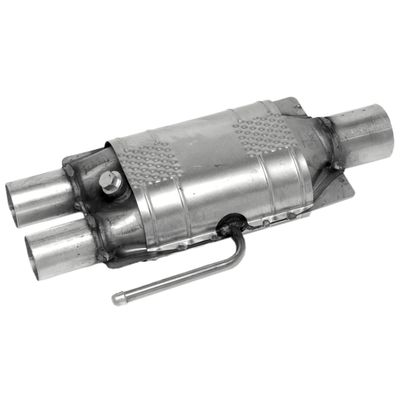Answer
Aug 20, 2024 - 08:18 AM
Identifying your catalytic converter is important for various reasons, such as determining its value, ensuring compatibility during replacement, or reporting it if it's stolen. Here’s how you can identify your catalytic converter:
1. Locate the Catalytic Converter- Under the Vehicle: The catalytic converter is usually located along the exhaust system, between the engine and the muffler. On most vehicles, it’s positioned underneath the car, near the center or towards the back.
- In the Engine Bay: On some vehicles, particularly those with transverse engines, the catalytic converter might be located closer to the engine or integrated into the exhaust manifold.
- Stamped Numbers: Most catalytic converters have a serial number or part number stamped or engraved into the metal casing. This number is often located on a flat surface of the converter, either on the top or side.
- Manufacturer’s Code: The serial number often includes a code representing the manufacturer, followed by a series of numbers that indicate the specific model of the converter.
- Vehicle Information: Knowing the make, model, and year of your vehicle can help you identify the catalytic converter. Different vehicles use different converters, and some models may have multiple converters depending on the engine configuration.
- Vehicle Identification Number (VIN): Sometimes, the VIN can be used to look up specific parts for your vehicle, including the catalytic converter.
- OEM Parts Lookup: Many websites and parts stores offer OEM parts lookup tools where you can enter your vehicle's details to find the exact catalytic converter used in your car.
- Recycling Databases: Some recycling and scrap metal websites have databases where you can enter the serial number or part number to identify the catalytic converter and its potential value.
- Shape and Size: Different catalytic converters have unique shapes, sizes, and designs. High-flow converters, for example, might look different from standard converters. Knowing the general shape and size can help in identification.
- Oxygen Sensor Ports: The number and position of oxygen sensor ports can also help identify the converter. Some converters have built-in oxygen sensors, which can be a distinguishing feature.
- Owner’s Manual: Some owner’s manuals include part numbers for specific components, including the catalytic converter.
- Manufacturer or Dealer: Contacting the vehicle manufacturer or a dealership with your VIN can help you identify the specific catalytic converter used in your vehicle.
- Label or Sticker: Some catalytic converters have a label or sticker that includes identification information, such as the manufacturer’s name, serial number, and emission compliance details. These are often found on newer converters.
- Take Clear Photos: If you're having trouble reading the numbers on your catalytic converter, take clear photos in good lighting. This can help you compare with online resources or show to a professional for assistance.
- Beware of Aftermarket Converters: If your vehicle has had its catalytic converter replaced, it may have an aftermarket unit that could have a different identification number or appearance than the OEM part.
Identifying your catalytic converter involves locating it on your vehicle, finding and reading the serial or part number, and using that information to determine its specifics. If you’re unsure, consulting with a professional mechanic or using an online parts lookup tool can provide further assistance.





Add New Comment